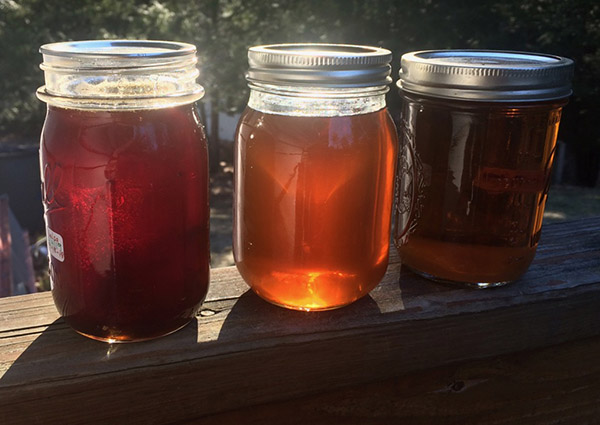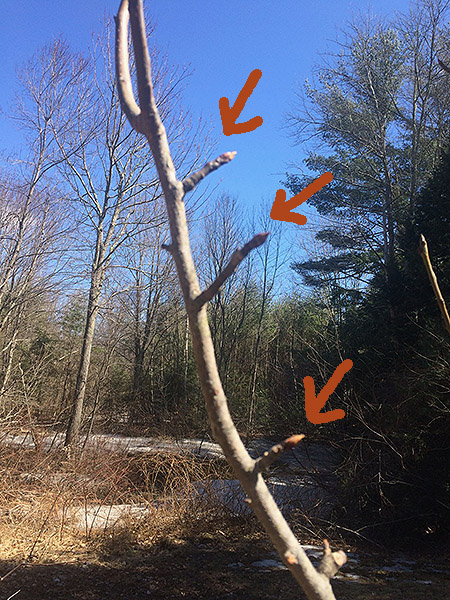The maple syrup season ended, but other Spring chores quickly fill the void that had been tapping and boiling. While that task is done, self-sufficiency always has something else to tend to. It’s far too early to plant, but there is plenty to do before that point.
Syrup Summary
This year’s harvest actually turned out to be only one pint less than last year’s. If it hadn’t been for burning one two-gallon boil (total loss), we might have matched the previous year’s total. The final count was a surprise because shortly after putting in the taps, we had two weeks of bitter cold in which the nights were zero or below and the days seldom got into the low 20s. For the sap to flow, the trees want below-freezing nights and above-freezing days — preferably with sunshine on their trunks. For two weeks, we had none of the above.
Yet, it seemed that when the weather got more optimal, the trees made up for lost time. We boil two gallons of sap at a time rather than save it up and boil a huge batch all at once, as many of the local sugar houses do. When the sap was flowing fast, we could not keep up. For a while, boiling dominated the Dear Wife’s days. A few cloudy, cool days slowed the sap enough to work through our backlog and keep pace.

Toward the end, the sap had a little darker tinge to it. Typically, it’s water clear. This tinged sap yielded a very dark syrup (see photo) compared to a typical pint. It seems to taste fine. Old timers tell of the syrup taking on a “woody” taste toward the end of the season. Perhaps I don’t have connoisseur taste buds enough to identify “woody.” Seemed fine to me.
So, the dark jar will go down in the cupboard with the other preserves — the leftovers from last fall’s harvest canning. Reducing our dependence on industrial food is nice.
Tree Trimming

Late March or very early April is a bit late to prune the fruit trees but not too late. The buds have not yet swollen with new life, so the trees are still dormant. My trees are still too young to be worrying about sawing off branches. I’m more engaged in shape-management.

Trimming was mostly of the new growth shoots from last year, removing a third or so of the new growth, clipping just above a bud. This will encourage branching rather than height. There are a few internal
Speaking of fruit, it was fun to see the many fruit spurs while pruning. They’re stubby little stems with bigger (some say more-wrinkled) buds. (red arrows in the photo) Assuming the thieves can be kept at bay, the apple and pear trees look set to produce an excellent crop this summer. But, much like not counting chickens before they hatch, don’t count your spurs and think they’ll all be apples.
Coop Clean & Compost
Up next will be clearing out the chicken coop(s) and run of the “dirt” that is their floors. The chickens have been making compost all fall and winter. I keep a deep litter floor of shredded leaves in the coop — plain leaves in the run.
This is what I do with the abundance of autumn leaves that fall on the yard here at the homestead. Many get shredded and put into a big plywood hopper for winter use. Another hopper made of old pallets houses unshredded leaves for the run. The chickens like to scratch among dry leaves, so it gives them something to do during the prolonged winter confinement.
I add more shredded leaves to the coop periodically during the winter to keep ammonia down. With just those two ingredients: dried leaves and chicken poop, the result (by the end of winter) is several inches of dark, rich “dirt.”
All of that chicken compost (five or six wheelbarrow fulls) needs to go sit on the compost pile for a month or two to mellow. Chicken poop’s high nitrate levels can be a little “hot” for young plants. When it’s time to till and plant, we’ll sift the compost to get a fine organic supplement to put on our gardens.
I have to rebuild the left-hand compost bin. The old pallets have rotted into instability. All winter, we’ve been watching for free pallets set alongside the road. We scored several good ones. They’ll go out for the firewood to be stacked upon. The old wood-stack pallets will get “promoted” to compost bin construction.
Seems like it’s always busy times.
